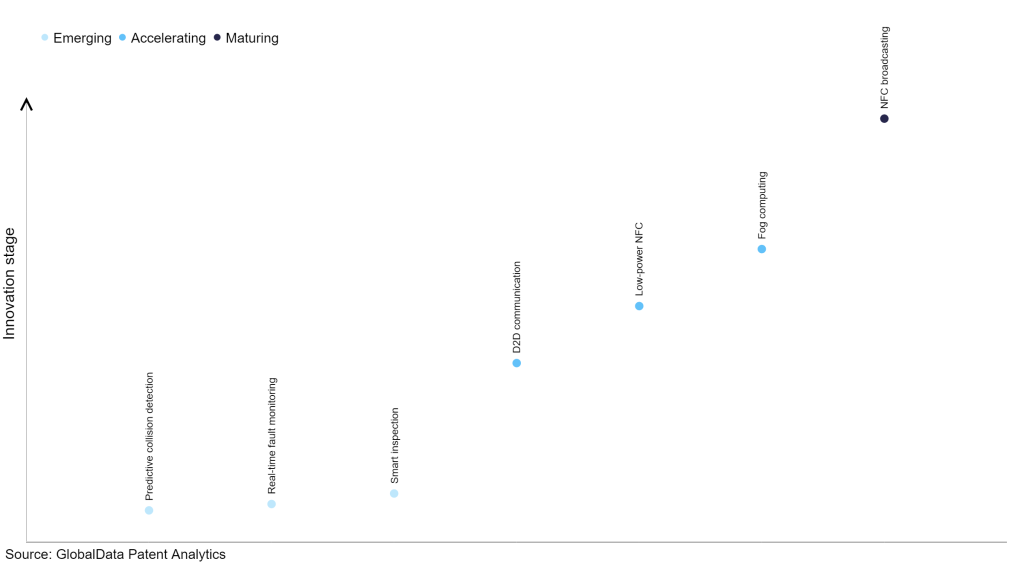The technology industry continues to be a hotbed of patent innovation. Activity is driven by the increasing demand for secure and convenient wireless communication in industries like retail, healthcare, and transportation, along with the drive for energy-efficient IoT solutions, and growing importance of technologies such as near field communication (NFC) chips for secure communication, low-power protocols for extended battery life, and IoT platforms for seamless integration and management of NFC-enabled devices, collectively driving advancements in low-power NFC IoT solutions. In the last three years alone, there have been over 1.5 million patents filed and granted in the technology industry, according to GlobalData’s report on Internet of Things in technology: low-power NFC. Buy the report here.
However, not all innovations are equal and nor do they follow a constant upward trend. Instead, their evolution takes the form of an S-shaped curve that reflects their typical lifecycle from early emergence to accelerating adoption, before finally stabilizing and reaching maturity.
Identifying where a particular innovation is on this journey, especially those that are in the emerging and accelerating stages, is essential for understanding their current level of adoption and the likely future trajectory and impact they will have.
185+ innovations will shape the technology industry
According to GlobalData’s Technology Foresights, which plots the S-curve for the technology industry using innovation intensity models built on over 1.6 million patents, there are 185+ innovation areas that will shape the future of the industry.
Within the emerging innovation stage, predictive collision detection, real-time fault monitoring and smart inspection are disruptive technologies that are in the early stages of application and should be tracked closely. D2D communication, low-power NFC and fog computing are some of the accelerating innovation areas, where adoption has been steadily increasing. Among maturing innovation areas is NFC broadcasting, which is now well established in the industry.
Innovation S-curve for Internet of Things in the technology industry

Low-power NFC is a key innovation area in Internet of Things
Low-power near field communication involves employing NFC technology with a focus on conserving energy. The aim is to achieve efficiency by minimizing the power required for data transmission and reception, ultimately leading to prolonged battery life and heightened effectiveness.
GlobalData’s analysis also uncovers the companies at the forefront of each innovation area and assesses the potential reach and impact of their patenting activity across different applications and geographies. According to GlobalData, there are 295 companies, spanning technology vendors, established technology companies, and up-and-coming start-ups engaged in the development and application of low-power NFC.
Key players in low-power NFC – a disruptive innovation in the technology industry
‘Application diversity’ measures the number of applications identified for each patent. It broadly splits companies into either ‘niche’ or ‘diversified’ innovators.
‘Geographic reach’ refers to the number of countries each patent is registered in. It reflects the breadth of geographic application intended, ranging from ‘global’ to ‘local’.
Patent volumes related to low-power NFC
Source: GlobalData Patent Analytics
Among the companies innovating in low-power NFC, Sony Group is one of the leading patents filers. The company’s patent describes the process for a communication device by checking if a first radio frequency (RF) signal surpasses a specific threshold. If it doesn't and the device is instructed to generate a second RF signal, it creates one at a level higher than the first threshold. The device then picks up a load-modulated RF signal in response to the second RF signal. Other prominent patent filers in the space include Samsung Group and Johnson & Johnson.
In terms of application diversity, Johnson & Johnson held the top position, while Apple and Sony Group stood in second and third positions, respectively. By means of geographical reach, Johnson & Johnson leads the pack, followed by Apple and Meta Platforms.
Low-power NFC is highly significant in IoT as it allows for efficient and secure short-range communication between devices, while conserving energy. The technology is pivotal in enabling a wide range of IoT applications, from contactless payments and smart access control to asset tracking, by ensuring prolonged battery life and seamless connectivity.
To further understand the key themes and technologies disrupting the technology industry, access GlobalData’s latest thematic research report on Internet of Things.
Data Insights
From

The gold standard of business intelligence.
Blending expert knowledge with cutting-edge technology, GlobalData’s unrivalled proprietary data will enable you to decode what’s happening in your market. You can make better informed decisions and gain a future-proof advantage over your competitors.







